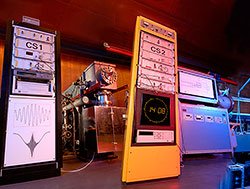Time and Entropy: Why time is not running backwards - Part 1

© Chakis Atelier/ thinkstockNeither the burning of a candle, nor the breaking of a glass: Most of the processes in our world are irreversible. They cannot be undone nor reverted. Why? The reason for this is the nature of time and especially of entropy: Because order always aspires to disorder, time cannot run backwards.
Since Albert Einstein's Relativity Theory we know, that time is not a constant: It changes over the influence of gravity and high speed. But is time reversible? In Science-Fiction movies, time travelling is a popular motivation for action, but physics forbids the roll back of time.
Why this is the case and why thermodynamics and entropy have to do with it, I would like to show you with my upcoming articles about this topic, from which this is the first part.
Part 1: The size of Time
How we capture time
For all of us, the year 2017 started with a day lasting one second longer than usually - this additional leap second was necessary for world time, which is represented by precise clocks, to bring it into synchronization with earth rotation thus with the change of night and day. The earth is not rotating in a consistent way, because shifting of masses have influence to the rotation speed. Further, day length is increasing constantly, because tidal friction slows down rotation.

Change of day and night defines the rhythm of terrestrials
© NASA While natural daily rhythm is crucial for our time experience, some people's work consists of building more and more accurate clocks. In a pendulum clock the insight is used, that the period of oscillation of a pendulum depends on its length, but not on its amplitude, making division of time into seconds become reality.
References for time measurement
As a unit, seconds were based on the periodic change of day and night and were defined as the 86,400 fraction of a mean solar day. In the year of 1967 it was internationally decided to not define the duration of a second from the day length, but rather through the oscillation of a microwave signal, which is generated by an atomic clock.

Atomic clock © PTB Since 1978 the time signal which is relevant for public life is generated by an atomic clock of the Phyiscal-Technical Federal Institute in Braunschweig Germany (PTB) and is sent out in the near of Frankfurt for radio-controlled clocks. But how can someone be sure about which periodic procedure to use, to show the "right" ticking away of time?
The time also goes by without us
Even though the hour glass may break, no more sunlight may fall in the dark, or even when the main spring may run out, making the watch hand stand still - time keeps going on. In the best case the clock shows this process. And because time only knows its own speed, like the heartbeat or the rhythm of tides, clocks do not contain the time. They only try to keep up with it - if they can.
That's how the author Dava Sobel writes about the entity of time in her book "Längengrad" which basically means longitude.
Time takes its path, regardless of somebody missing it or not. At first this is nothing unusual. Similar to space, which was present before we invented units of length. However, our experience of this two occurrences is different, because while space simply is present and contains no direction, time always moves forward into one single direction.
A circular argument? The problem with clocks

Looking forward to your other articles because I am not fully convinced about your concept "Because order always aspires to disorder, time cannot run backwards". Both seem to be true (at least for us) but one is not necessarily the root of the other. There are processes where (using energy) disorder is converted to order (constructing things, buildings out of less organized materials) and over evolutionary timespans it seems that there is a thrive for order (higher organized lifeforms), isn´t it. And there is the thing about the time arrow which always goes in one direction. But really not sure if the time arrow or lets say more exact our inability to revert it has something to do with the second law of TD.
Hi @stayoutoftherz! Thanks for your reply!
I actually released the fifth (and last) part of this article series yesterday. Maybe you missed the follow-up link above. There is basically a follow-up link in every article except the last one of course.
Time and Entropy: Why time is not running backwards - Part 2
would be the next part if you are interested, which together with the ones following, will cover some of your questions. I would be glad to hear about your opinion after you have read them.
Finally I would like to tell you, that I am already working on my next article series, which will be about time and perception.
Check out my announcement post about it:
Perception of Time - Wanna stay informed?
and follow me, to stay informed.
By "follow-up" do you mean this was an intentional cliffhanger?
Hello, yes what I mean is that there will be 4 more articles related to this topic. This is going to be an article series.
You've been UpVoted via the UpVote Experiment 002 Bot. Depending on my VP & the price of STEEM you should get a $.01-$.03 for your trouble.
Read more about this experiment here.
Thank You - @blueorgy
@n3bul4 got you a $3.6 @minnowbooster upgoat, nice! (Image: pixabay.com)
Want a boost? Click here to read more!